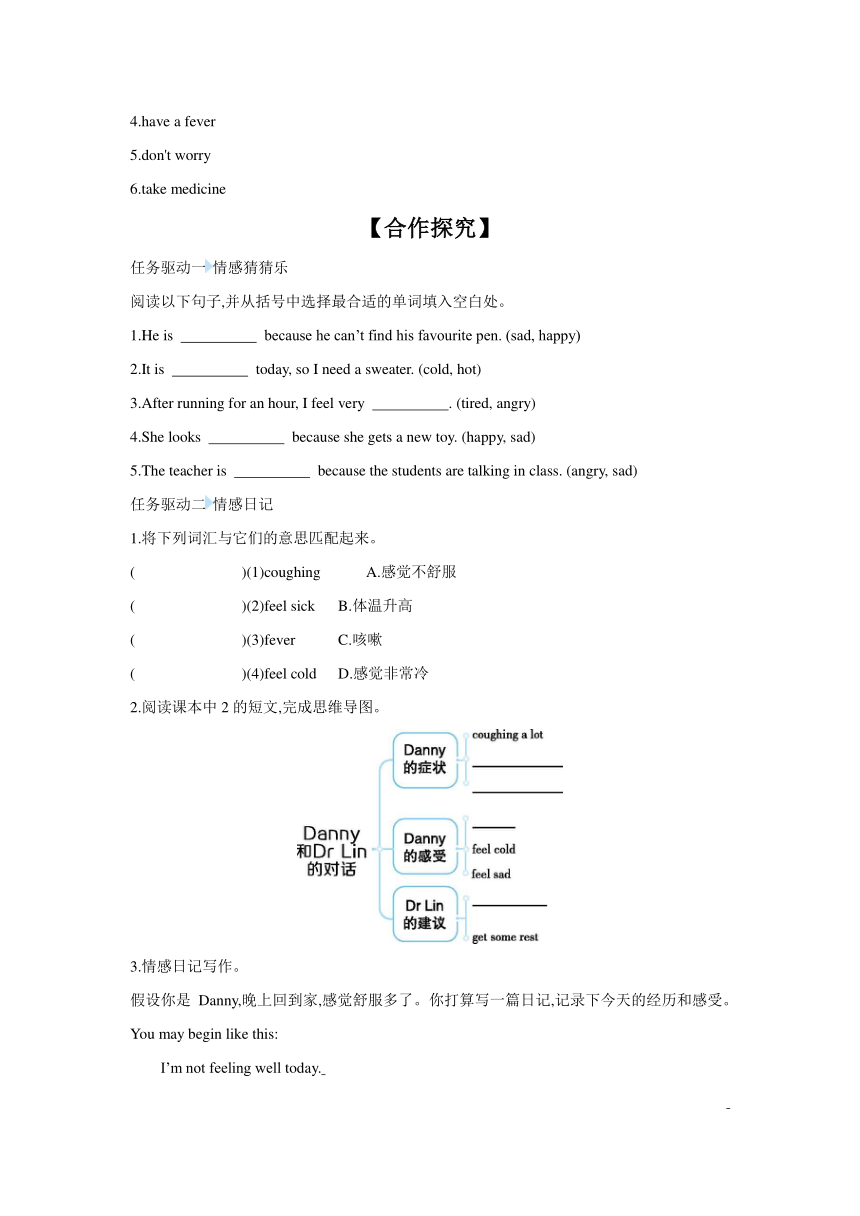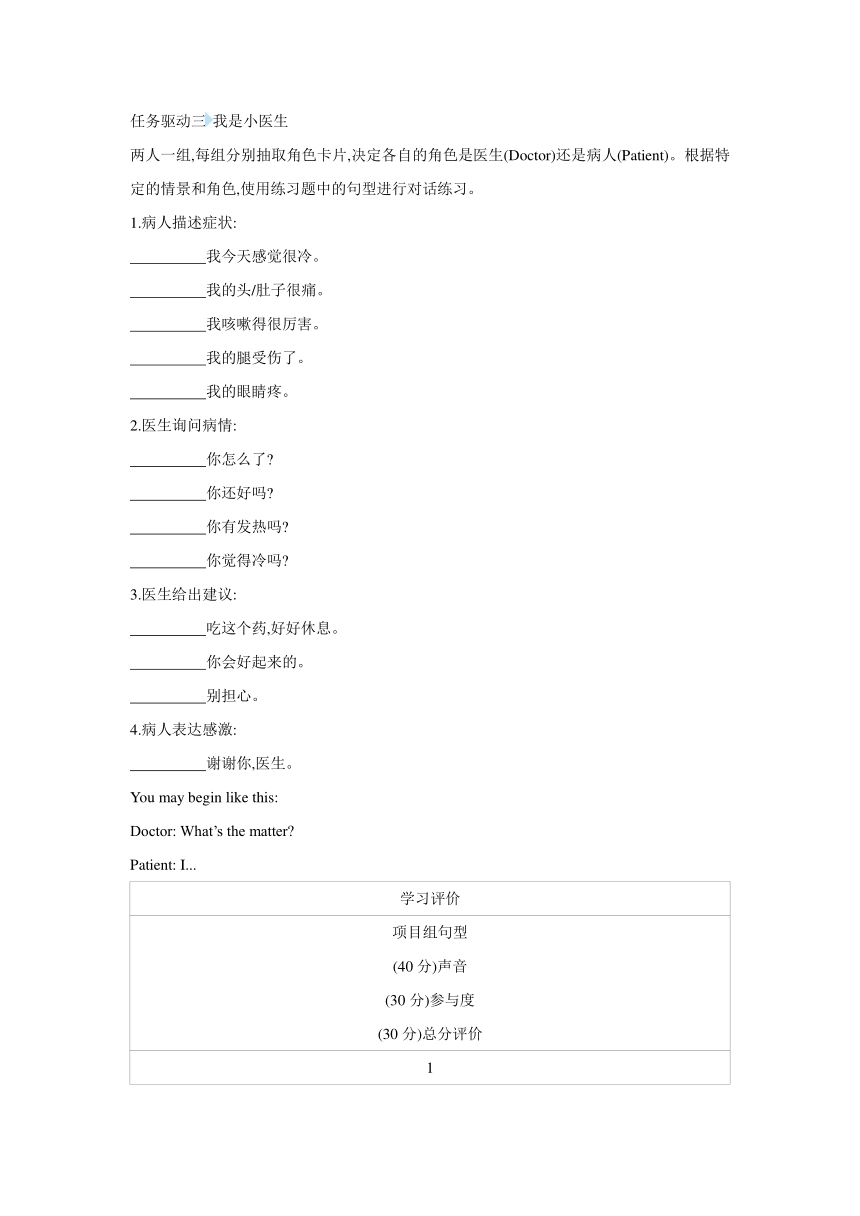【学习任务单】Unit 3 Lesson 2 How do you feel (含答案) 2024-2025学年英语冀教版七年级上册
文档属性
| 名称 | 【学习任务单】Unit 3 Lesson 2 How do you feel (含答案) 2024-2025学年英语冀教版七年级上册 |

|
|
| 格式 | docx | ||
| 文件大小 | 53.7KB | ||
| 资源类型 | 教案 | ||
| 版本资源 | 冀教版 | ||
| 科目 | 英语 | ||
| 更新时间 | 2024-12-26 20:13:41 | ||
图片预览



文档简介
Unit 3 Lesson 2 How do you feel
【学习目标】
1.正确使用英语词汇描述自己的感受。
2.通过阅读短文并完成思维导图,提高阅读理解能力和信息整合能力。
3.通过活动了解医患交流的基本礼仪,同时意识到健康的重要性。
【自主预习】
一、生词速查。
1. n.事情;问题;物质
2. v.咳嗽
3. n.头疼
4. n.发烧;发热;狂热
5. n.药;医学
6. n.休息时间;剩余部分 v.休息;放松
二、短语速记。
1. 怎么了
2. 感觉不舒服
3. 头疼
4. 发热
5. 别担心
6. 吃药
【答案】
一、
1.matter 2.cough 3.headache 4.fever 5.medicine 6.rest
二、
1.what's the matter
2.feel sick
3.have a headache
4.have a fever
5.don't worry
6.take medicine
【合作探究】
任务驱动一情感猜猜乐
阅读以下句子,并从括号中选择最合适的单词填入空白处。
1.He is because he can’t find his favourite pen. (sad, happy)
2.It is today, so I need a sweater. (cold, hot)
3.After running for an hour, I feel very . (tired, angry)
4.She looks because she gets a new toy. (happy, sad)
5.The teacher is because the students are talking in class. (angry, sad)
任务驱动二情感日记
1.将下列词汇与它们的意思匹配起来。
( )(1)coughing A.感觉不舒服
( )(2)feel sick B.体温升高
( )(3)fever C.咳嗽
( )(4)feel cold D.感觉非常冷
2.阅读课本中2的短文,完成思维导图。
3.情感日记写作。
假设你是Danny,晚上回到家,感觉舒服多了。你打算写一篇日记,记录下今天的经历和感受。
You may begin like this:
I’m not feeling well today.
任务驱动三我是小医生
两人一组,每组分别抽取角色卡片,决定各自的角色是医生(Doctor)还是病人(Patient)。根据特定的情景和角色,使用练习题中的句型进行对话练习。
1.病人描述症状:
我今天感觉很冷。
我的头/肚子很痛。
我咳嗽得很厉害。
我的腿受伤了。
我的眼睛疼。
2.医生询问病情:
你怎么了
你还好吗
你有发热吗
你觉得冷吗
3.医生给出建议:
吃这个药,好好休息。
你会好起来的。
别担心。
4.病人表达感激:
谢谢你,医生。
You may begin like this:
Doctor: What’s the matter
Patient: I...
学习评价
项目组句型 (40分)声音 (30分)参与度 (30分)总分评价
1
2
3
4
5
【答案】
任务驱动一
1.sad 2.cold 3.tired 4.happy 5.angry
任务驱动二
1.(1)C (2)A (3)B (4)D
2.have a headache have a fever feel sick take medicine
任务驱动三
1.I feel cold today.
I have a headache/stomachache.
I am coughing a lot.
I hurt my leg.
My eyes hurt.
2.What's wrong/What's the matter
Are you okay
Do you have a fever
Do you feel cold
3.Take this medicine and have a good rest.
You'll be okay.
Don't worry.
4.Thank you, Doctor.
【知识超市】
I have a stomachache. 我肚子痛。
用法总结 have在英语中可以用来表示患病,通常与特定的病症或不适状态结合使用,构成短语。例如:
He has a bad headache.他头痛得厉害。
Do you have a toothache 你牙痛吗
素养训练 翻译下列句子。
1.他头痛。
_____________________________________________________________________
2.我得了重感冒。
_____________________________________________________________________
用法总结 “-ache”是一个常见的英语后缀,形成名词,表示持续的疼痛或不适。它通常附加在身体部位之后,用来描述该部位的疼痛,如:headache“头痛”、toothache “牙痛”、stomachache“肚子痛”、backache“背痛”、earache“耳痛”等。
素养训练 使用正确的“-ache”结尾的词汇完成句子。
1.I have a after working. (头痛)
2.The loud music gives me an . (耳痛)
3.He has a from sitting at his desk all day. (背痛)
4.My sister has a serious because she eats lots of candy. (牙痛)
【答案】
素养训练
1.He has a headache.
2.I have a bad cold.
素养训练
1.headache 2.earache 3.backache 4.toothache
Take this medicine and get some rest. 吃了这药,好好休息。
用法总结 祈使句用于表达请求、命令、叮嘱、建议等,通常省略主语“you”。例如:
Open the door! 打开门!
1.以系动词be开头的祈使句。
这种句式的结构:Be动词+其他成分(形容词、名词或介词短语等)。例如:
Be quiet, please! 请安静!
2.以实义动词开头的祈使句。
这种祈使句的常用结构:动词原形+其他成分。例如:
Come in, please!请进!
3.let句型的祈使句。
这种祈使句的常用结构:Let’s/let us+动词原形;或者是Let +宾语+其他。例如:
Let’s play football! 我们一起踢足球吧!
素养训练 翻译下列句子。
1.让我来帮你。
_____________________________________________________________________
2.吃些蔬菜吧。
_____________________________________________________________________
3.请起立。
_____________________________________________________________________
【答案】
1.Let me help you.
2.Eat some vegetables.
3.Stand up, please.
【学习目标】
1.正确使用英语词汇描述自己的感受。
2.通过阅读短文并完成思维导图,提高阅读理解能力和信息整合能力。
3.通过活动了解医患交流的基本礼仪,同时意识到健康的重要性。
【自主预习】
一、生词速查。
1. n.事情;问题;物质
2. v.咳嗽
3. n.头疼
4. n.发烧;发热;狂热
5. n.药;医学
6. n.休息时间;剩余部分 v.休息;放松
二、短语速记。
1. 怎么了
2. 感觉不舒服
3. 头疼
4. 发热
5. 别担心
6. 吃药
【答案】
一、
1.matter 2.cough 3.headache 4.fever 5.medicine 6.rest
二、
1.what's the matter
2.feel sick
3.have a headache
4.have a fever
5.don't worry
6.take medicine
【合作探究】
任务驱动一情感猜猜乐
阅读以下句子,并从括号中选择最合适的单词填入空白处。
1.He is because he can’t find his favourite pen. (sad, happy)
2.It is today, so I need a sweater. (cold, hot)
3.After running for an hour, I feel very . (tired, angry)
4.She looks because she gets a new toy. (happy, sad)
5.The teacher is because the students are talking in class. (angry, sad)
任务驱动二情感日记
1.将下列词汇与它们的意思匹配起来。
( )(1)coughing A.感觉不舒服
( )(2)feel sick B.体温升高
( )(3)fever C.咳嗽
( )(4)feel cold D.感觉非常冷
2.阅读课本中2的短文,完成思维导图。
3.情感日记写作。
假设你是Danny,晚上回到家,感觉舒服多了。你打算写一篇日记,记录下今天的经历和感受。
You may begin like this:
I’m not feeling well today.
任务驱动三我是小医生
两人一组,每组分别抽取角色卡片,决定各自的角色是医生(Doctor)还是病人(Patient)。根据特定的情景和角色,使用练习题中的句型进行对话练习。
1.病人描述症状:
我今天感觉很冷。
我的头/肚子很痛。
我咳嗽得很厉害。
我的腿受伤了。
我的眼睛疼。
2.医生询问病情:
你怎么了
你还好吗
你有发热吗
你觉得冷吗
3.医生给出建议:
吃这个药,好好休息。
你会好起来的。
别担心。
4.病人表达感激:
谢谢你,医生。
You may begin like this:
Doctor: What’s the matter
Patient: I...
学习评价
项目组句型 (40分)声音 (30分)参与度 (30分)总分评价
1
2
3
4
5
【答案】
任务驱动一
1.sad 2.cold 3.tired 4.happy 5.angry
任务驱动二
1.(1)C (2)A (3)B (4)D
2.have a headache have a fever feel sick take medicine
任务驱动三
1.I feel cold today.
I have a headache/stomachache.
I am coughing a lot.
I hurt my leg.
My eyes hurt.
2.What's wrong/What's the matter
Are you okay
Do you have a fever
Do you feel cold
3.Take this medicine and have a good rest.
You'll be okay.
Don't worry.
4.Thank you, Doctor.
【知识超市】
I have a stomachache. 我肚子痛。
用法总结 have在英语中可以用来表示患病,通常与特定的病症或不适状态结合使用,构成短语。例如:
He has a bad headache.他头痛得厉害。
Do you have a toothache 你牙痛吗
素养训练 翻译下列句子。
1.他头痛。
_____________________________________________________________________
2.我得了重感冒。
_____________________________________________________________________
用法总结 “-ache”是一个常见的英语后缀,形成名词,表示持续的疼痛或不适。它通常附加在身体部位之后,用来描述该部位的疼痛,如:headache“头痛”、toothache “牙痛”、stomachache“肚子痛”、backache“背痛”、earache“耳痛”等。
素养训练 使用正确的“-ache”结尾的词汇完成句子。
1.I have a after working. (头痛)
2.The loud music gives me an . (耳痛)
3.He has a from sitting at his desk all day. (背痛)
4.My sister has a serious because she eats lots of candy. (牙痛)
【答案】
素养训练
1.He has a headache.
2.I have a bad cold.
素养训练
1.headache 2.earache 3.backache 4.toothache
Take this medicine and get some rest. 吃了这药,好好休息。
用法总结 祈使句用于表达请求、命令、叮嘱、建议等,通常省略主语“you”。例如:
Open the door! 打开门!
1.以系动词be开头的祈使句。
这种句式的结构:Be动词+其他成分(形容词、名词或介词短语等)。例如:
Be quiet, please! 请安静!
2.以实义动词开头的祈使句。
这种祈使句的常用结构:动词原形+其他成分。例如:
Come in, please!请进!
3.let句型的祈使句。
这种祈使句的常用结构:Let’s/let us+动词原形;或者是Let +宾语+其他。例如:
Let’s play football! 我们一起踢足球吧!
素养训练 翻译下列句子。
1.让我来帮你。
_____________________________________________________________________
2.吃些蔬菜吧。
_____________________________________________________________________
3.请起立。
_____________________________________________________________________
【答案】
1.Let me help you.
2.Eat some vegetables.
3.Stand up, please.
同课章节目录
